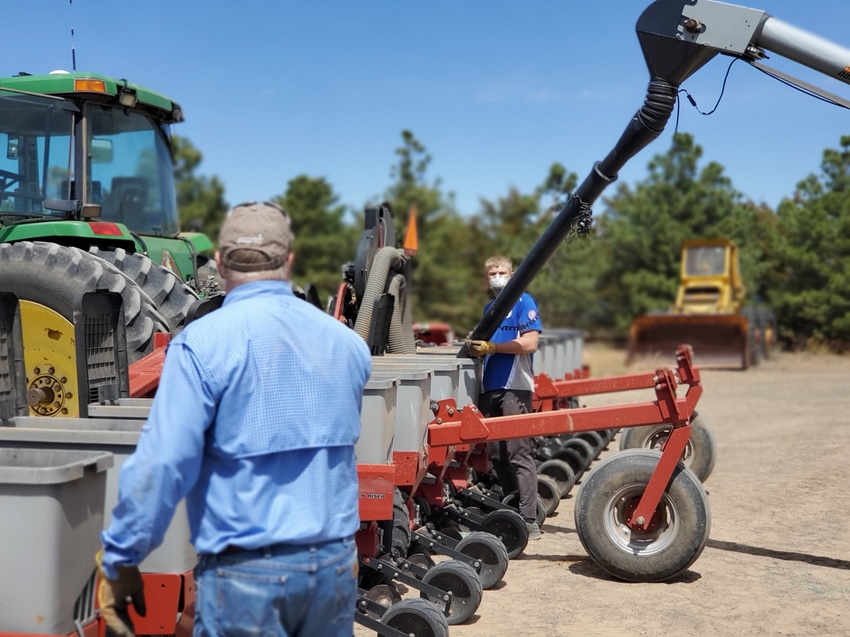May 8, 2020

Since the beginning of the COVID-19 pandemic, many agricultural commodity prices have dropped 20% to 30%, according to a new report released by the Agricultural and Food Policy Center at Texas A&M University. Many Texas producers have already experienced losses, and if prices do not recover soon for livestock and prior to row crop harvest, they could easily see losses in the range of $6 billion to $8 billion – down 27% to 36% overall.
“Our goal in producing the COVID-19 Economic Impact to Texas Agriculture report was to frame agricultural issues related to the COVID-19 pandemic, as well as provide insights and discussion on how various production agriculture commodities in Texas were affected,” said Joe Outlaw, Texas A&M AgriLife Extension Service agricultural economist and co-director of the center.
The report notes row crops such as corn, cotton, wheat, sorghum, rice, and soybeans have been especially hard hit.
“Farmers are going into this crop year with crop insurance price elections that are lower than in the past two years,” Outlaw said. “This means farmers could lose 20% to 30% of their crops before getting any benefit from insurance.”
He said row crops in Texas are either planted and growing in most regions or are about to be planted in the northern part of the state.
“The only losses row crop farmers would currently be incurring are from the sale of 2019 crops from storage,” Outlaw said. “And while Texas producers typically do not store commodities this far into the marketing year, many continue to work through carryover stocks from the 2019 crop year.”
He said while all row crops are affected, wheat and rice may fare somewhat better due to their being consumer staples.
Outlaw said risk management strategies, crop insurance and farm bill program provisions will play a key role in providing relief for depressed prices, but absent additional aid, the financial stress producers were already facing is likely to grow significantly.
“Row crop producers are now being asked to take on a lot of risk to grow crops that very well may lose them a lot of money,” Outlaw said.
For Texas row crop agriculture, the most immediate and visible impact is on commodity market prices, he said, but effects can reasonably be expected to ripple through the industry supply chain from production inputs to retail consumers.
Livestock and dairy
Many of the losses related to livestock are a result of shifting demand from food consumed away from home to food consumed at home. Processing plant closures also threaten to drive prices paid to producers even lower in the wake of reduced demand. At the same time, retail prices are increasing due to reduced supply.
“While a lot of losses have yet to materialize, for those producers marketing now, including dairy products, which are marketed daily, the pain is immediate,” Outlaw said.
Texas is the fifth- largest milk-producing state in the U.S., and the shift from restaurants to grocery store sales has hit the industry especially hard. A large share of milk products, including cheese and butter and other products, goes through food service outlets and with the loss of those outlets, milk processing quickly found themselves with more milk than they could sell as finished products.
On the livestock side, the report notes both futures and cash prices of stocker cattle, feeder cattle and calf prices have dropped dramatically as the societal impacts of COVID-19 took hold.
“Stocker cattle producers are facing significant price losses as calves purchased in the autumn, long before the COVID-19 pandemic, have been selling at much lower prices. The impacts of COVID-19 on individual ranches will depend on the production system but will eventually accrue to all cow-calf producers.”
The COVID-19 pandemic has created substantial economic losses across all livestock agriculture, Outlaw said. This impact will be felt over the course of the year as sales occur, production responds to financial losses and more long-term economic effects become apparent.
Specialty crops
Similar to livestock, many of the losses in specialty crops—primarily composed of fruits and vegetables—are related to shifting demand.
“The specialty crop sector has been one of the hardest-hit sectors of agriculture due to the COVID-19 pandemic,” Outlaw said. “Most fruits and vegetables are consumed fresh and are highly perishable, and as a result of the COVID-19 pandemic, the closure of most restaurants and schools has caused a major reduction in demand.”
He noted while the reduction in demand in some areas has translated to higher demand at grocery stores, different packaging requirements, changes in volume demanded, altered consumer purchasing habits, and overall uncertainty are all having a negative effect on produce prices—mainly at the farmgate level.
If COVID-19 issues persist, Texas fruit and vegetable producers could be left without outlets for their highly perishable products and ultimately could lose over $397 million.
Financial relief for farmers and ranchers
The report also notes the federal government has responded with a series of three stimulus or relief acts agricultural producers may benefit from — the most useful likely being the Coronavirus Aid, Relief, and Economic Security Act, also known as the CARES Act. Along with authorizing additional funding for the U.S. Department of Agriculture so it may provide direct assistance to agricultural producers, the CARES Act established the Payroll Protection Program.
A detailed description of all three legislative responses can be found in the “Initial COVID-19 Response for Agricultural Producers” publication recently issued by the Agricultural and Food Policy Center.
“While farmers and ranchers are grateful for the assistance the federal government is providing, many of their financial difficulties are immediate, and if not quickly addressed could have long-term negative effects on much of the state’s agricultural production,” Outlaw said.
Source: is AgriLife TODAY, which is solely responsible for the information provided and is wholly owned by the source. Informa Business Media and all its subsidiaries are not responsible for any of the content contained in this information asset.
About the Author(s)
You May Also Like




